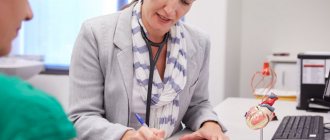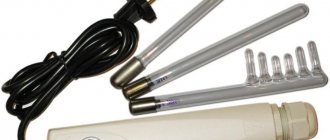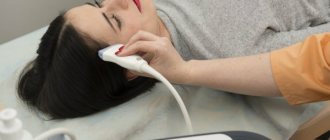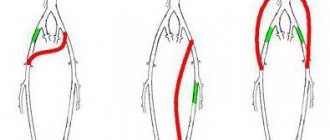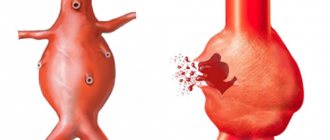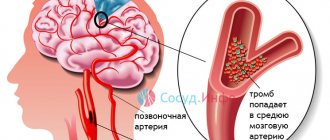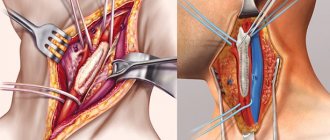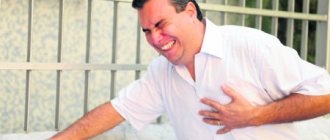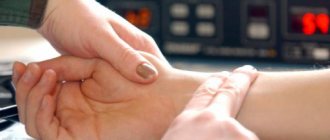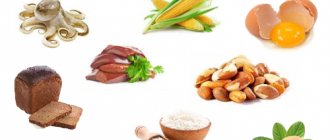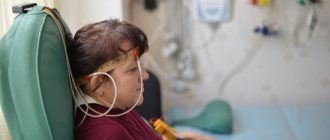Beat to the heart - should I use a precordial beat?
Often, in case of cardiac arrest, people are advised to strike the heart area with a fist, which, according to the plan, should restore normal heart function. You should be aware that this may not only be useless, but also dangerous.
You can use a precordial beat only if all of the following indications are present at the same time:
- No more than 1 minute has passed since the heart stopped. The blow should be delivered as soon as possible - the sooner, the more likely it is to start a normal heart rhythm.
- There is no electrical defibrillator at your disposal.
- The victim’s age is over 8 years, body weight is more than 15 kilograms.
Technique of precordial stroke
If you are in doubt and never know the exact technology and indications for a cardiac stroke, then abandon this method and immediately begin chest compressions.
Lay the patient down on a hard surface - this is extremely important; no sofas are suitable. Place your index and middle fingers on the xiphoid process (marked with an arrow in the picture), then use the edge of your clenched fist to hit the sternum firmly above the fingers.
Your elbow should be pointing along your spine . The blow is carried out from a height of about 20 centimeters (for physically weak people from 30 cm), with the hand withdrawn from the chest.
Only one blow should be applied (although some researchers suggest two blows); if the heartbeat has not recovered (check on the carotid artery), then proceed to chest compressions.
Precautionary measures
- You cannot strike if there is a pulse on the carotid artery - the heart is already working and, in this case, a strike can only stop it.
- Never hit the xiphoid process.
- It is very important that your elbow is directed along the spine when striking, this will make the strike more effective and minimize the likelihood of damage to the chest.
- If you have thin fingers and the victim is large, then place your ring finger (three fingers at once) on the xiphoid process.
Precordial stroke: where to apply it during first aid and the essence of the method, whether it is prohibited or not
Sazykina Oksana Yurievna, cardiologist
Sudden cardiac death in recent years is not as rare as it used to be, and has become more common even in young patients. This condition can happen anywhere - on the street, on public transport, at sporting events, etc.
In this regard, any person, and not only a medical worker, must know how to correctly and timely provide emergency assistance to the victim. This is especially true for such techniques as precordial stroke.
Of course, when carrying out such a strike, there are rules, which will be discussed below.
So, a precordial stroke is a method of physical impact on the chest of a patient who has suffered cardiac arrest.
Such an effect can translate physical vibrations of the anterior chest wall and the wall of the heart into electrical excitation of the fibers of the heart muscle, since the heart tissue has the property of electrical excitability, as a result of which its mechanical irritation can provide an electrical impulse response.
In other words, the mechanical effect on the heart area is a kind of mechanical pacemaker, thanks to which the normal cardiac cycle can start again.
However, a number of authors are inclined to believe that such an effect is not enough to produce a full-fledged electrical systole, capable of ensuring adequate ejection of blood into the aorta, and, consequently, ensuring blood flow to the brain. There has been a lot of debate about this effect on the heart in the medical literature, and yet at the present time:
A precordial shock is considered an effective resuscitation aid, but only if the patient actually has a cardiac arrest, and the shock was carried out in the first 30-40 seconds after that.
Compatibility of alcohol and VSD
There is a myth that bad habits, including alcohol, are the “joys of life,” and if you consider that alcohol dilates blood vessels, which lowers blood pressure, improves well-being and mood, then alcohol is a panacea for all medications.
Let's destroy this myth: firstly, the presence of bad habits is considered the cause of the development of VSD. Statistics show that people who smoke and drink a lot of alcohol are more likely to develop vascular dystonia.
Secondly, you should study the effect of alcohol on the body.
Alcohol is the cause of the development of VSD, and if consumed, the patient’s condition will only worsen.
The fact is that when alcohol enters the body, it strikes the central nervous system, thereby inhibiting the process of conditioned inhibition of its work.
After 6 hours, intoxication of the body with alcohol breakdown products begins. Therefore, alcohol will only worsen the pathological condition of VSD.
Alcohol increases vascular tone, but after it leaves the body, the vessels sharply contract, which causes a heavy blow to the cardiovascular system.
Consequences of alcohol consumption during VSD
Drinking alcohol in the presence of VSD is fraught not only with a severe hangover (which occurs much faster than in healthy people), but also with a powerful load on the blood vessels and heart.
Moreover, if you engage in physical work in this state, the risk of developing a stroke or heart attack increases.
Regular consumption of alcohol can lead a person with VSD to a state of alcoholism, and heavy consumption will provoke frequent panic attacks and the development of depression. In case of hypertensive dystonia, alcohol is generally prohibited.
Types of alcoholic drinks, effects on the body
Each type of alcoholic drink has its own effect on the body of a VSD person. If there is a “burning” desire to “lift your mood,” then it is better to drink red wine - the drink helps to avoid a hangover.
Dry wine and cognac can increase blood pressure for a short time, and then add heart pain and tachycardia. But beer has the most destructive qualities. Beer is usually consumed in large quantities due to the fact that the drink is low in alcohol.
However, even a small bottle will cause a terrible hangover in an unhealthy person.
Hypertension will go away, and the pressure will be 120 over 80 if you include it in the diet...
Hypertension will disappear forever! Here's the secret...
on
Source: https://AptekaTamara.ru/bolezni/prekardialnyj-udar-nanosyat.html
Indirect cardiac massage technique. How to apply pressure on the heart correctly?
The starting position of the patient is lying on his back, on a hard and flat horizontal surface. Place something under the shins to raise the victim's straight legs 20-30 centimeters above the head.
Which area to press on?
You should press with straight arms exactly perpendicular to the victim’s chest to ensure sufficient pressing force (the sternum of an adult should bend by 5 centimeters) and save your own strength. At the same time, it is also important not to overdo it - the maximum compression depth is 6 cm.
The easiest and most acceptable way is to mentally draw a line and place your palms exactly in the middle. Another option is to determine the end of the xiphoid process, then place two or three fingers (depending on the thickness of your fingers) of one hand on it and place the palm of the other hand close to them. This is the right point for pressure, which will allow you to minimize the risk of damage to the sternum and fracture of the victim’s ribs, and will also increase the effectiveness of cardiac massage.
Correct position of the palms during cardiac massage
When pressing, the hands can be taken in a “lock” or one on top of the other “crosswise”. We strongly recommend using the “lock”, because it becomes completely inconvenient to put pressure on the chest using flexion-extension movements of the arms - this ensures correct pressure with straight arms.
In addition, when placing your hands “crosswise”, you should additionally control the position of your fingers - they should be raised and should not touch the chest.
How to increase the effectiveness of cardiac massage?
After each press, the chest should be allowed to regain its shape. This means that you need to move your hands far enough, but at the same time do not lift them away from the body and do not slow down the frequency of compressions below 100 per minute.
You should be able to do 30 compressions in no more than 20 seconds. Ideally, you need to make them in 15 seconds, but better watch the quality. After this, proceed to artificial respiration (two of your exhalations into the victim).
Ideal scheme: 30 high-quality compressions (in 15-18 seconds), then two of your exhalations into the victim and again compressions until the patient regains consciousness or ambulance arrives.
How to do artificial respiration correctly?
- The starting position of the patient is lying on his back, on a hard and flat horizontal surface.
- You should tilt the victim's head back by pressing one hand on the victim's forehead and lifting his chin with the other.
- Next, inhale in proportion to the victim’s requirements. For example, if you are a hefty man, then you should not inhale for slaughter if your victim is a fragile girl or child. And in general, the inhalation should be normal, not full.
- Immediately after inhaling, exhale into the victim’s mouth through the protective barrier. In this case, you should definitely pinch his nose with your fingers, and also try to tightly clasp his mouth with your lips, and not touch them like when kissing. Do not forget about the correct position of the victim's head.
- Watch for the rise of the chest and abdomen (to do this, position your head correctly so that you can see the victim’s chest) - if your exhalation is successful, they will expand. Wait until the chest returns to its normal position (this will take a maximum of 5 seconds) and exhale a second time into the victim.
Correct position of the victim's head during artificial respiration
In each case of performing artificial breaths for the victim, you definitely need to lift his chin (with one hand we press on the forehead, with the other we lift the chin). In this position, the tongue does not block the airway. However, you should not tilt your head back too much, otherwise your abdomen will swell, which will seriously reduce the effectiveness of artificial ventilation.
Is it possible to get infected during artificial ventilation?
During artificial respiration, transmission of infection is possible (both for you and for the victim), so you should use a special barrier device placed on the patient’s open mouth. Car first aid kits contain special valves. In the complete absence of any means, use any fabric, at least to protect against possible vomit.
Keep in mind that without using special protective equipment, you can catch such a serious disease as tuberculosis. Therefore, if the victim does not inspire confidence, then it would be better to limit himself to one cardiac massage (without performing artificial respiration).
Precordial stroke: indications, application technique, features
Restoring heart rhythm after clinical death or precordial stroke is classified as a method of cardiopulmonary resuscitation. Directed physical impact on the heart is a chest shake.
It is carried out with simultaneous monitoring of the pulse. Sudden cardiac arrest occurs in young and old people. Mastery of the precordial impact method is the only way to help the victim.
Indications for use
In what cases is it advisable to use this method? Indications for performing a resuscitation push when providing first aid are the following borderline conditions in humans:
Before performing a blow, it is necessary to expose the area of impact, lay the person on a horizontal, flat surface and position the hands correctly to avoid negative consequences (rib fracture, low impact force will not bring the desired effect).
It is imperative to diagnose the onset of sudden cardiac arrest, since with a healthy rhythm of cardiac activity, a blow can damage the musculoskeletal frame, cause pain to a person, and even cause sudden asystole.
There are contraindications to the use of shock techniques, which in some cases can harm the patient. Among them are:
Physiological aspect
The precordial blow is used when providing first aid to the victim. Sharp compression of the chest triggers the contractile reflex. The ventricles of the heart fill with blood. The rhythm is restored. A sharp compression of the chest forms an impulse. Directed mechanical energy provokes excitation at the nerve endings.
The shock is carried out within the first 65 seconds after the onset of sudden cardiac arrest. After 1.5-2 minutes of clinical death, the method is useless.
Indications and contraindications
Cardiologists have identified a list of indications for which a precordial stroke is performed.
| Indications | Contraindications |
| Loss of consciousness - the patient cannot feel a pulse | A “thread-like” pulse is recorded in one of the arteries of the victim. |
| The onset of sudden clinical death. Its duration does not exceed 45 seconds | Presence of breathing movements |
| Development of sudden ventricular arrhythmia | Convulsive muscle contractions |
| – | Presence of injury in the chest area |
| – | Age up to 10 years |
| – | Body weight up to 15 kg |
After 5 minutes of resuscitation measures, the physician makes a conclusion about the occurrence of death. Unfortunately, surgery does not always restore the heart rhythm. Doctors recommend stopping all attempts to revive the patient if several signs are present. The first is that the eyes do not respond to the influence of a light stimulus. The second sign is that the epidermis changes color.
Signs of cardiac arrest, emergency care
Sudden cardiac arrest has characteristic symptoms that develop rapidly:
- loss of consciousness;
- absence of pulsation in the carotid artery;
- respiratory depression up to complete absence;
- pale cyanotic skin tone;
- lack of pupillary reflex;
- muscle cramps (not always).
Sometimes cardiac arrest is preceded by chest pain, severe dizziness, an attack of nausea, severe weakness and increasing shortness of breath at rest. But more often, cardiac activity stops suddenly and without warning.
The main goal of CPR during sudden cardiac arrest is to restore effective myocardial contractions. When circulatory arrest occurs due to ineffective cardiac activity, oxygen starvation of the cerebral cortex occurs in a matter of minutes. Therefore, the algorithm of actions in this situation must be strictly debugged so that valuable time is not wasted when the consequences are still reversible.
The main stages of action when an unconscious person is detected:
- In the first 15 seconds, it is determined whether the person is alive or dead. To do this, signs of true death are determined - clouding of the corneas and the appearance of a cat's pupil when pressing on the eyeball (Beloglazov's symptom). The pulse is felt in the carotid artery. Positive signs and the absence of a pulse indicate the death of the victim; there is no point in performing resuscitation.
Beloglazov's sign ("cat's eye") - If there is a reaction to a painful stimulus (checking Beloglazov’s symptom) and a pulse is palpable, the victim is conscious. Helping him is to call an ambulance and create peace.
- There is a pulse, but there is no reaction to pain - the victim is in a coma. In this case, they place him on his stomach, apply cold to his head and call an ambulance.
- There is no pulse, but there are no signs of biological death - a state of clinical death. It is urgent to begin cardiopulmonary resuscitation: a precordial blow is applied, chest compressions and mouth-to-mouth/nose breathing are performed.
If the victim has lost consciousness in front of eyewitnesses, first of all it is necessary to make sure that there is a pulse in the carotid artery. If the pulsation is preserved, he is placed with the lower limbs raised up, freed from compressive things, given access to fresh air and called an ambulance. If there is no pulse, begin CPR .
To provide assistance in case of sudden cardiac arrest, you should remember the procedure using the abbreviation UNI: precordial Beat, Indirect cardiac massage, Artificial ventilation (breathing from mouth to mouth / mouth to nose). This will help you remember the procedure for CPR, which can be performed by random eyewitnesses.
The patient will be saved by prompt and correct actions
The victim is placed on a flat and hard surface. The man lies on his back. The cardiologist is inclined to prohibit performing the shock on a bed or soft surface. It absorbs kinetic energy. The procedure loses its effectiveness. The further procedure is as follows:
- the pulse is checked in the carotid and femoral arteries;
- absence of a pulse is a reason to immediately call an ambulance;
- An assistant calls the doctors, and the person begins resuscitation;
- at the point where the blow will be struck, they are freed from clothing;
- everything is removed from the victim’s clothing pockets - small and not so small objects will damage the skin during the manipulation;
- a right-handed person places the index and middle finger of his left hand in the solar plexus area on the chest;
- the fingers are placed at the so-called point of convergence of the ribs (solar plexus) - the more accurately the point is found, the less the risk of violating the integrity of the xiphoid process;
- a left-handed person repeats what was described above with only one difference - they use the fingers of the right hand;
- the second hand, which will receive the impact (blow), is clenched into a fist;
- the cardiologist is inclined to prohibit applying the impact with the edge of the palm;
- the clenched fist is raised above the point where the blow will be struck by 25 cm;
- the person who carries out resuscitation measures sits on the side of the victim;
- the hand clenched into a fist is located above the heart area and parallel to the body;
- the elbow of the hand clenched into a fist “looks” towards the victim’s navel;
- deliver a sharp blow at equal intervals no more than 2 times;
- after each sudden impact, check the pulse in the carotid and femoral arteries.
As soon as the pulse is recorded, a cardiac massage is performed. It is performed before the ambulance arrives. Correct implementation of recommendations increases a person’s chances of survival. In percentage terms, the situation looks like this. Of every 10 victims who were hit, at least 6-7 survived.
A precordial blow is administered to children under 10 years of age with great caution - this kind of resuscitation is possible only after a detailed calculation of the force of impact. There shouldn't be any mistakes. There is a high risk of damaging the child's internal organs.
Precordial stroke is a method of restoring heart rhythm in the event of clinical death. The essence of the manipulation is reduced to a sharp effect on the chest. If the procedure is carried out within the first 45 seconds after the onset of clinical death, there is a high probability of resuscitating the victim. Resorting to a blow is allowed in the case when the performer masters the technique perfectly. Mistakes are not allowed.
When is it necessary to perform a precordial stroke?
The indication for carrying out this resuscitation aid when providing first aid is the absence of an independent heartbeat in the patient, which is caused by ventricular fibrillation and/or asystole (cardiac arrest) due to other rhythm disturbances. Clinically, asystole, which caused clinical death, is accompanied by such signs as:
- Loss of consciousness
- Absence of pulse in the carotid and femoral arteries,
- Dilated pupils with lack of reaction to light,
- Lack of independent breathing movements,
- The presence of a blue tint on the skin of the face, neck, and hands.
If the doctor has the ability to conduct an ECG or cardioscopy using a monitor on a defibrillator, ventricular fibrillation, electromechanical dissociation of the heart and asystole can be reliably detected.
The algorithm for diagnosing cardiac arrest is as follows:
- If a person falls and loses consciousness, you should call out to him and shake him by the shoulder. It is unacceptable to hit a person on the cheeks; you can sprinkle water on your face.
- If there is no reaction, feel the pulse fluctuations of the carotid artery (at the angle of the lower jaw), assess the presence of independent respiratory movements - see if there is an excursion of the chest, listen to the sound of exhaled air with your ear or feel the exhaled air with your cheek (the “look, listen, feel” algorithm ).
- In the absence of pulse and respiratory movements, immediately begin performing a precordial stroke with further indirect cardiac massage and artificial ventilation using artificial respiration.
